1440p high refresh screens for laptops are finally here, both in 15-inch and 17 inch sizes. XMG have sent both their Neo 15 and Neo 17 gaming laptops to me to test these panels out, so let’s get straight into some testing results and gaming benchmarks to find out if these panels are worth considering.
Response time test
These are the response time results for the 15-inch panel. 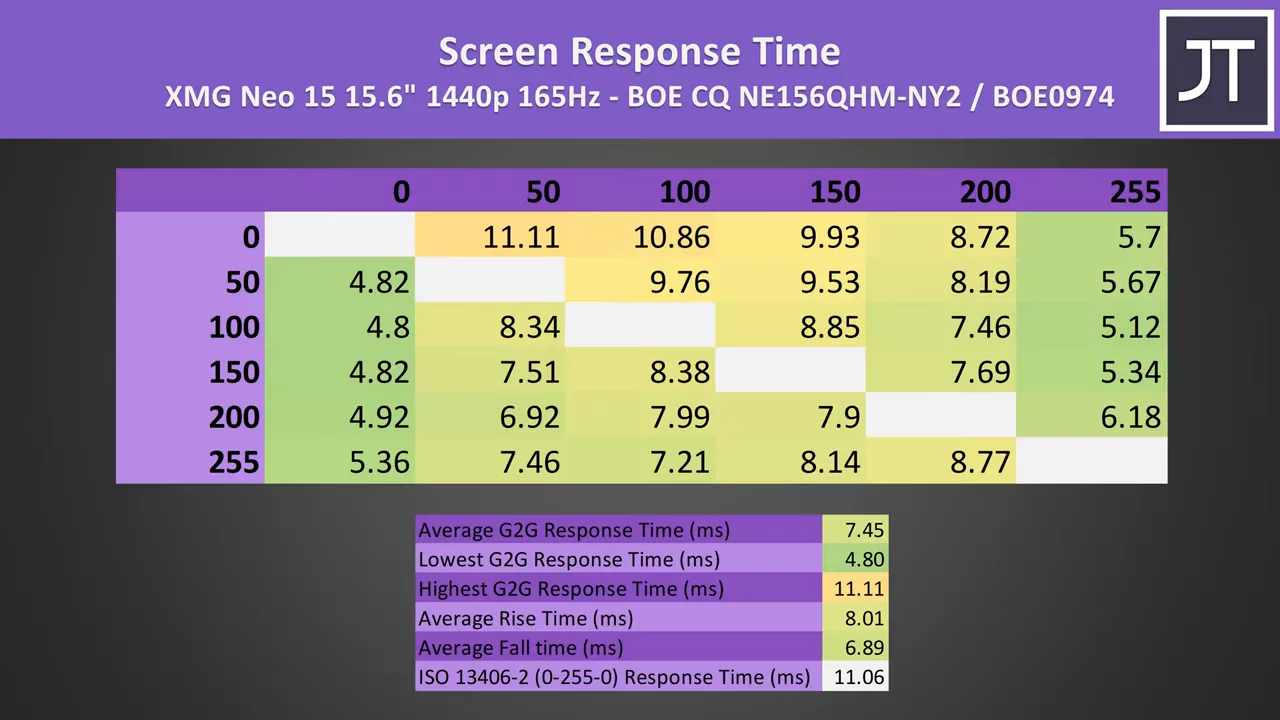 The key takeaway is that we’re looking at a 7.45ms average grey-to-grey response time.
The key takeaway is that we’re looking at a 7.45ms average grey-to-grey response time. 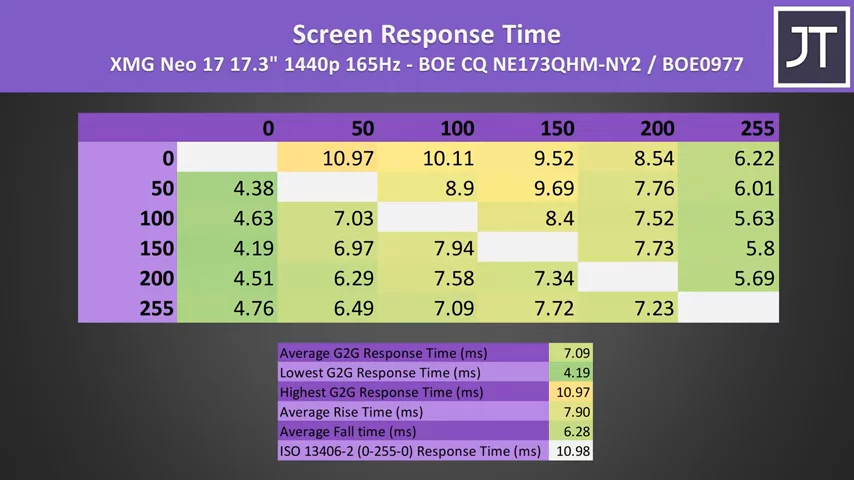 The 17-inch panel was slightly faster at 7.09ms on average, though results can vary a bit even between two screens of the same model, so it’s hard to say if the 17 inch will always be a little ahead.
The 17-inch panel was slightly faster at 7.09ms on average, though results can vary a bit even between two screens of the same model, so it’s hard to say if the 17 inch will always be a little ahead. 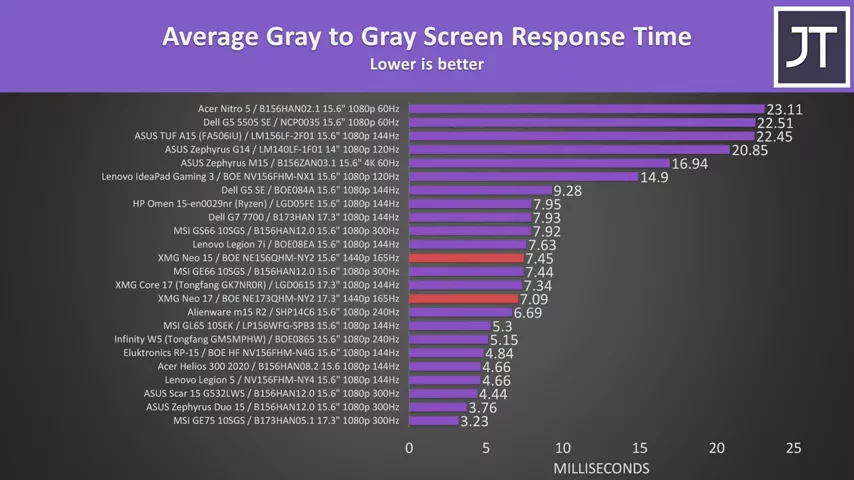 These results aren’t too bad when we look at how they compare against other high refresh 1080p panels. For a 165Hz panel, ideally we want to see a response time of 6.06ms for transitions to occur within the refresh window. We’re not too far off this, and some transitions were faster, but regardless I didn’t notice any ghosting while actually playing games.
These results aren’t too bad when we look at how they compare against other high refresh 1080p panels. For a 165Hz panel, ideally we want to see a response time of 6.06ms for transitions to occur within the refresh window. We’re not too far off this, and some transitions were faster, but regardless I didn’t notice any ghosting while actually playing games.
Brightness test
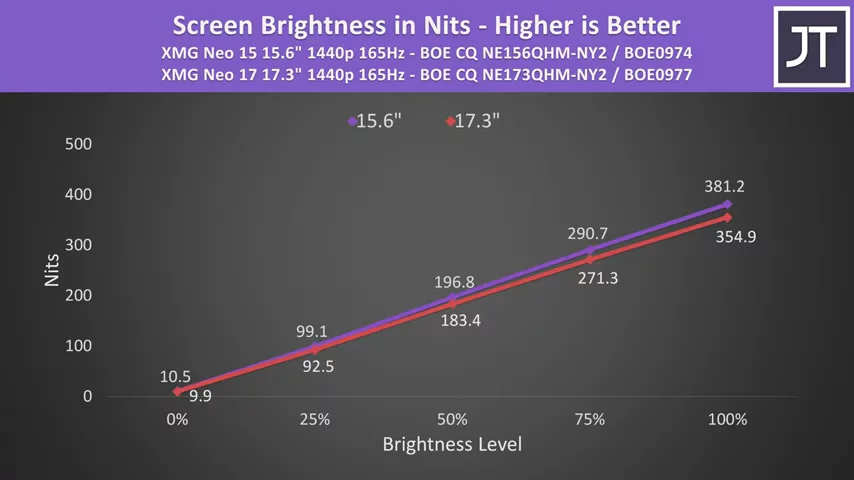 The 15-inch panel was a little brighter, but both are easily able to pass 300 nits at 100% brightness, which I think is a decent result for a gaming panel. Sure, not as good as some of the 500 nit options out there, but most gaming laptops I’ve tested are closer to the 300 point, so these are above average in brightness.
The 15-inch panel was a little brighter, but both are easily able to pass 300 nits at 100% brightness, which I think is a decent result for a gaming panel. Sure, not as good as some of the 500 nit options out there, but most gaming laptops I’ve tested are closer to the 300 point, so these are above average in brightness.
Contrast test
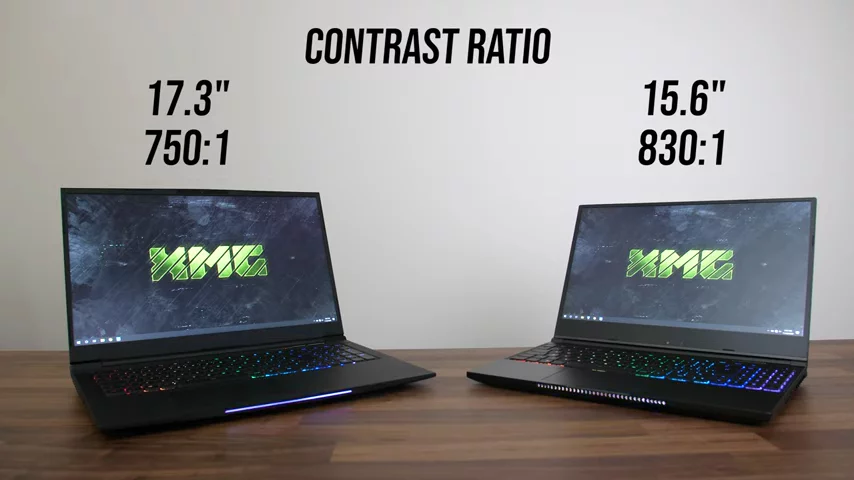 The contrast ratio was a little better on the 15-inch screen too, but both values are still within the ranges that I’ve typically seen with previous 1080p laptop screens.
The contrast ratio was a little better on the 15-inch screen too, but both values are still within the ranges that I’ve typically seen with previous 1080p laptop screens.
Color gamut test
 I’ve measured color gamuts too, and the 15 inch was a little better again, granted results can vary a bit even between panels of the same model. These are still decent results for a gaming laptop and fine for some content creation too.
I’ve measured color gamuts too, and the 15 inch was a little better again, granted results can vary a bit even between panels of the same model. These are still decent results for a gaming laptop and fine for some content creation too.
Backlight bleed
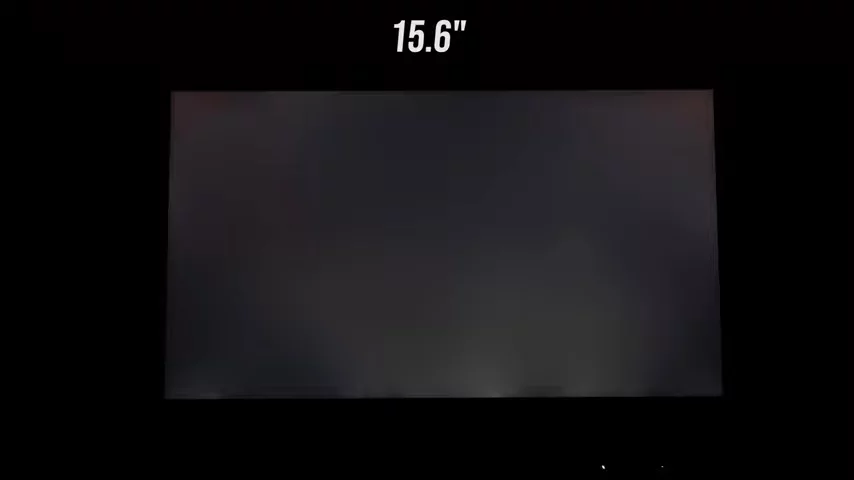 Backlight bleed wasn’t too bad with either panel, but this is always going to vary between units when it comes to backlit screens, pretty similar to the 1080p and 4K IPS options anyway.
Backlight bleed wasn’t too bad with either panel, but this is always going to vary between units when it comes to backlit screens, pretty similar to the 1080p and 4K IPS options anyway. 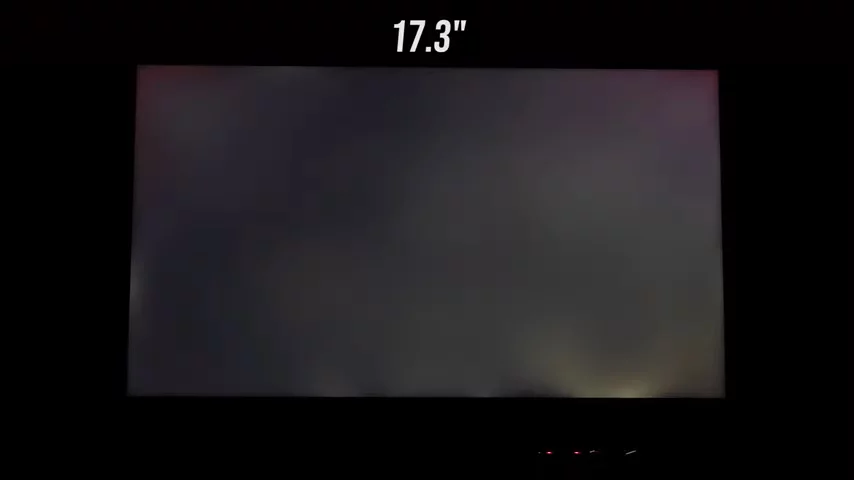
Battery life
The 1440p screen might use a little more power and affect battery life, but without two laptops the same with only the panel difference it’s difficult to measure properly.
15” vs 17”
So in terms of measurements, the 15-inch panel was slightly better in most regards, the exception being response time, where the 17 inch was a little faster. The differences weren’t too big though, and the scores coming out of both of them are pretty similar to what we’ve had available in 1080p options, perhaps even a little better.
Gaming benchmarks
Now let’s have a look at how well games actually run at 1440p. I’ve tested out the larger 17” model which has an 8 core Intel i7 CPU and full powered Nvidia RTX 2070 Super graphics, no Max-Q here.
Let’s start out with Shadow of the Tomb Raider.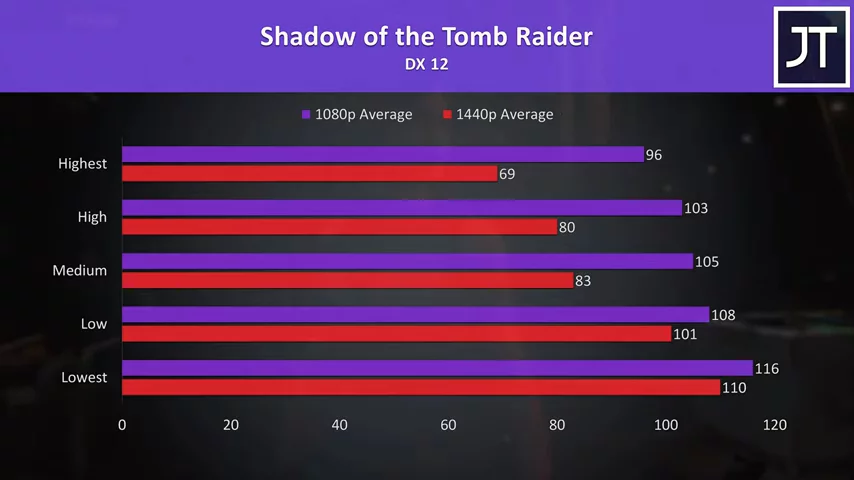 I’ve tested all setting levels with the lowest down the bottom and highest towards the top. I’ve got the 1440p results in the red bars, and the 1080p results above in the purple bars. We can see that the difference between them is only minor at the lower setting levels, but then at the higher presets which are presumably more GPU bound we see bigger gaps. We’re still able to surpass 60 FPS at 1440p with the highest setting preset, however the 1080p result is almost 40% faster.
I’ve tested all setting levels with the lowest down the bottom and highest towards the top. I’ve got the 1440p results in the red bars, and the 1080p results above in the purple bars. We can see that the difference between them is only minor at the lower setting levels, but then at the higher presets which are presumably more GPU bound we see bigger gaps. We’re still able to surpass 60 FPS at 1440p with the highest setting preset, however the 1080p result is almost 40% faster. 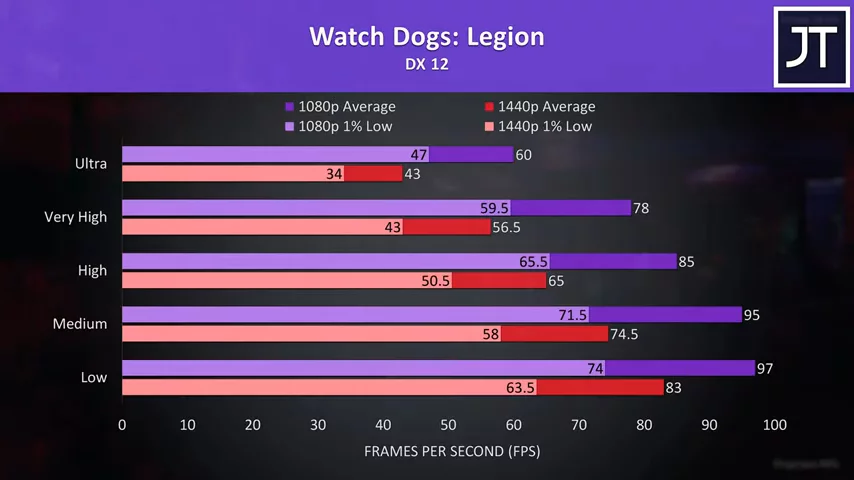 Watch Dogs Legion was hitting 60 FPS with the ultra setting preset at 1080p, which was again about 40% faster than the 1440p result underneath. Even the 1% low performance from 1080p was ahead of the average FPS at 1440p, but still 1440p was definitely more playable stepping down a setting level or two. While neither of these resolutions are making full use of the 165Hz refresh rate, the fact that we can still boost the resolution to 1440p is useful for making the image appear sharper, which is still a benefit even in games like this that don’t need high FPS to play well.
Watch Dogs Legion was hitting 60 FPS with the ultra setting preset at 1080p, which was again about 40% faster than the 1440p result underneath. Even the 1% low performance from 1080p was ahead of the average FPS at 1440p, but still 1440p was definitely more playable stepping down a setting level or two. While neither of these resolutions are making full use of the 165Hz refresh rate, the fact that we can still boost the resolution to 1440p is useful for making the image appear sharper, which is still a benefit even in games like this that don’t need high FPS to play well. 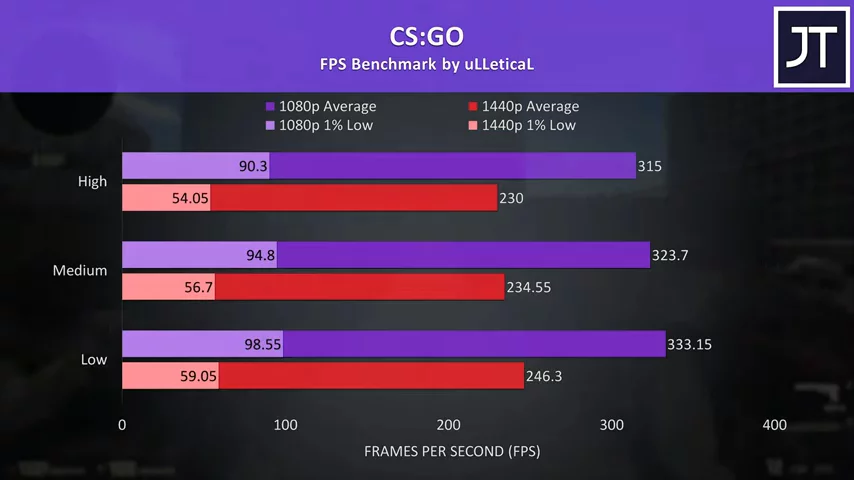 I’ve tested CS:GO as an eSports title to try and get an idea of what games are able to fully utilize the higher refresh rate even at 1440p, and this one certainly delivered. Even with all settings maxed out, the 1440p test was surpassing 200 FPS, though the 1080p frame rate was about 37% faster, a similar margin to the other games tested.
I’ve tested CS:GO as an eSports title to try and get an idea of what games are able to fully utilize the higher refresh rate even at 1440p, and this one certainly delivered. Even with all settings maxed out, the 1440p test was surpassing 200 FPS, though the 1080p frame rate was about 37% faster, a similar margin to the other games tested. 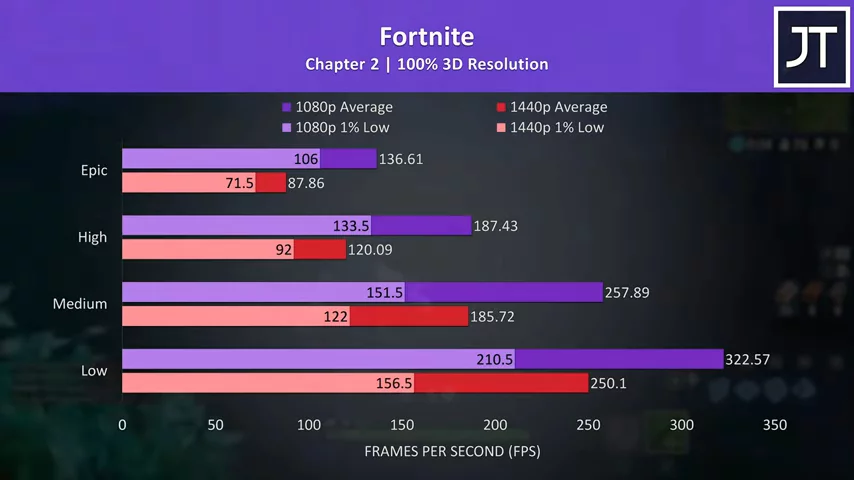 Fortnite is another game that can hit high frame rates pretty easily, and the medium setting preset was able to push the average frame rate above the refresh rate of the panel at 1440p. It was still playing well even with epic settings though, 1440p looks nicer in my opinion and the frame rate is still usable. This time the 1080p result was around 55% higher in average frame rate though, so more performance is lost in 1440p here compared to the previously tested games.
Fortnite is another game that can hit high frame rates pretty easily, and the medium setting preset was able to push the average frame rate above the refresh rate of the panel at 1440p. It was still playing well even with epic settings though, 1440p looks nicer in my opinion and the frame rate is still usable. This time the 1080p result was around 55% higher in average frame rate though, so more performance is lost in 1440p here compared to the previously tested games. 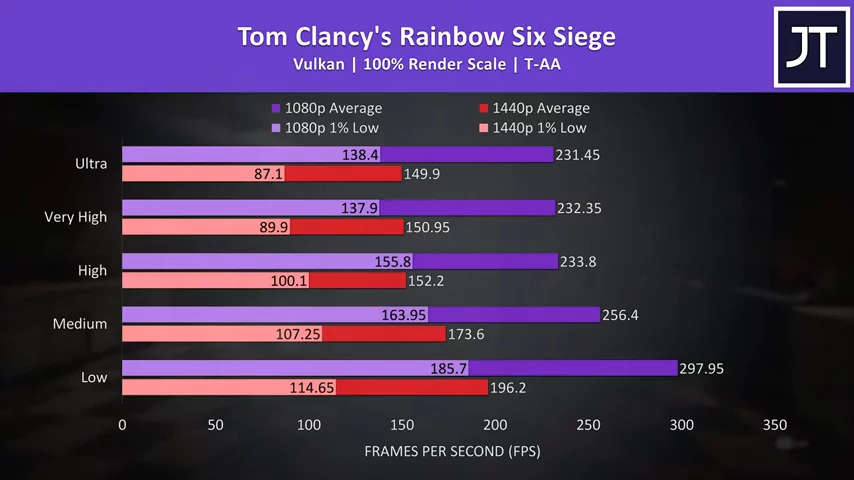 Rainbow Six Siege was similar, in that the 1080p performance was 54% ahead of the 1440p result with the highest ultra setting preset. Regardless though, at 1440p max settings we’re still at 150 FPS, so it should be possible to get some nice use out of the combination of higher resolution and high refresh rate.
Rainbow Six Siege was similar, in that the 1080p performance was 54% ahead of the 1440p result with the highest ultra setting preset. Regardless though, at 1440p max settings we’re still at 150 FPS, so it should be possible to get some nice use out of the combination of higher resolution and high refresh rate. 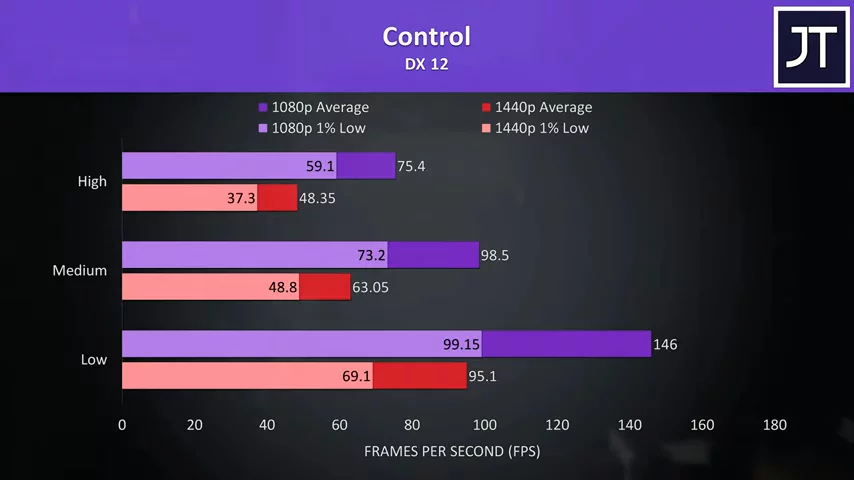 Control is fairly resource heavy, so it’s no surprise that 1080p at max settings was again around 56% faster when compared to 1440p. I thought the game still played well at 1440p, medium settings gets us above 60 FPS and I don’t think this game needs a super high frame rate to play, however we’ve also got the option of DLSS in this one.
Control is fairly resource heavy, so it’s no surprise that 1080p at max settings was again around 56% faster when compared to 1440p. I thought the game still played well at 1440p, medium settings gets us above 60 FPS and I don’t think this game needs a super high frame rate to play, however we’ve also got the option of DLSS in this one. 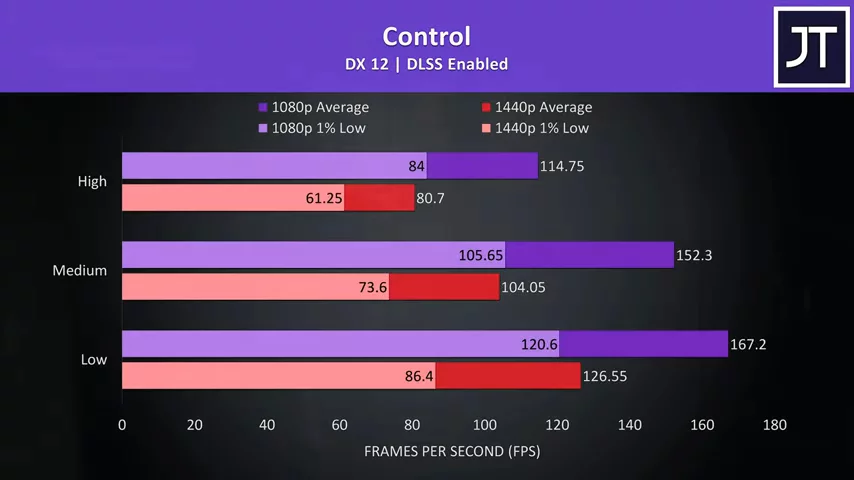 With DLSS enabled, even max settings at 1440p is now above 80 FPS and more than playable without issue while still looking quite good. Control is of course an example of a DLSS implementation that works well, this will vary by game but I think it’s a good example of a technology that can be used to further boost frame rate at 1440p even if you have a system with lower specs.
With DLSS enabled, even max settings at 1440p is now above 80 FPS and more than playable without issue while still looking quite good. Control is of course an example of a DLSS implementation that works well, this will vary by game but I think it’s a good example of a technology that can be used to further boost frame rate at 1440p even if you have a system with lower specs.
So as we’ve just seen, it will really depend on the specific game and how resource heavy it is as to whether or not you can run it at 1440p. The 2070 Super I’ve got definitely seems pretty capable though, which you’d expect from a higher end option. It will be interesting to see how lower specced laptops perform at 1440p once I get more for testing that have these screens.
These screens have almost 78% more pixels when compared to a 1080p screen, which does make the image look a little sharper, but yeah you also need more horsepower to power that in games. The higher 4K resolution does look a bit nicer still, but you need even more power for a good experience. Basically a top of the line laptop, so I think 1440p is a good middle ground, and I’m surprised it’s taken this long for us to have them in laptops.
GPU more useful in future
In many games, at 1080p we often don’t see too much improvement with higher graphics options, you start seeing diminishing returns at higher levels as the CPU is often still very important. This should start to shift a bit at 1440p though, especially at higher setting levels, as higher tier GPUs can get put to work.
Which 1440p size should you pick? PPI compared
Personally, at these sizes, I think the 17-inch 1440p screen makes more sense. With a 1080p 17-inch screen I could often notice the pixels, even when not sitting particularly close, and that hasn’t been the case with 1440p, and this is just something I’ve noticed less often when using a 15-inch laptop. That could just be me though, I just haven’t personally really noticed the pixels at 1080p in most cases, but that said even at 1440p the image did look noticeably sharper, and either way I think it’s great to have options. Those that do want 1440p at 15 inches now have that choice.
Windows scaling
By default, Windows set the resolution scaling to 150%, and I thought this looked fine, but 125% lets me fit more on the screen without being too small.
Pricing and availability
In terms of pricing, XMG have advised that the 1440p panels will be the same price as the 1080p 240Hz options, so it’s good that we’re not seeing a massive price hike. In terms of availability, the 17” panel should be some time around January next year, while the 15 inch is supposed to be late November, so very soon. I haven’t yet heard when other companies like ASUS or MSI for instance will start using these, but definitely expect it to happen.
Wait for next gen GPUs?
I wouldn’t be too surprised if we have announcements of next gen GPUs early next year, so it might be worth waiting before you pull the trigger and get a 1440p laptop, as more graphics power is definitely going to be useful there.
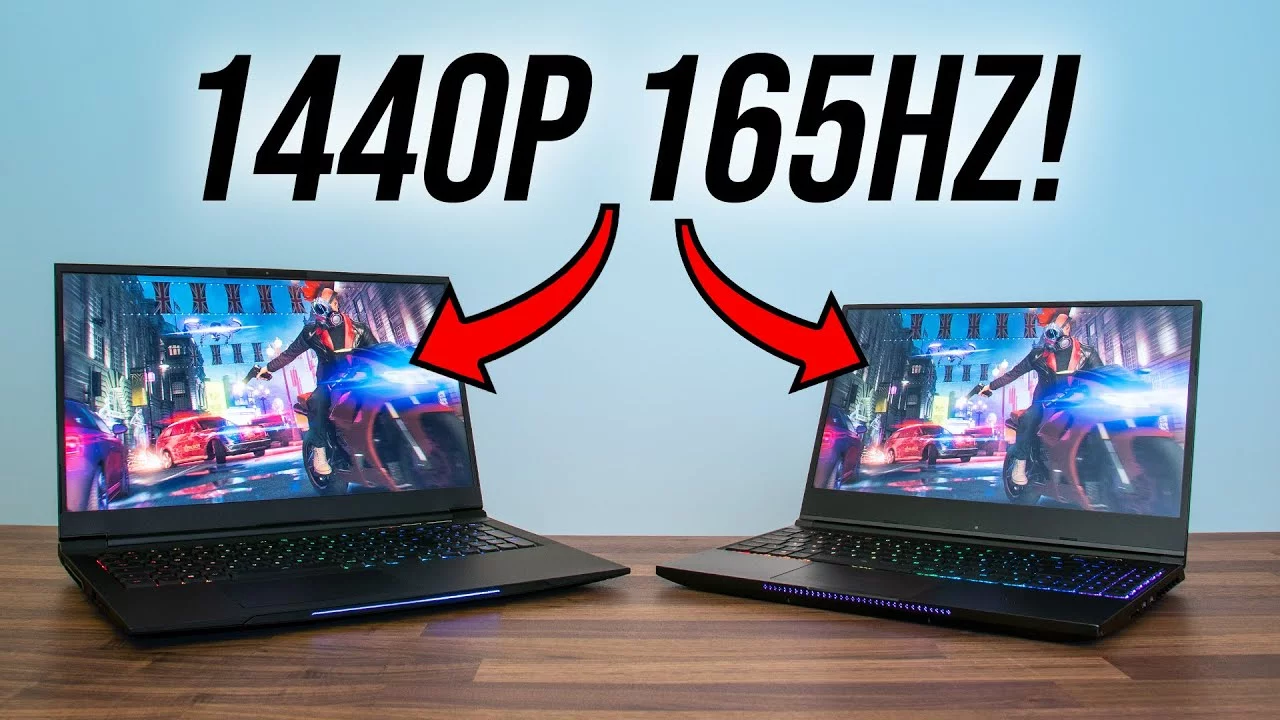

No comments yet